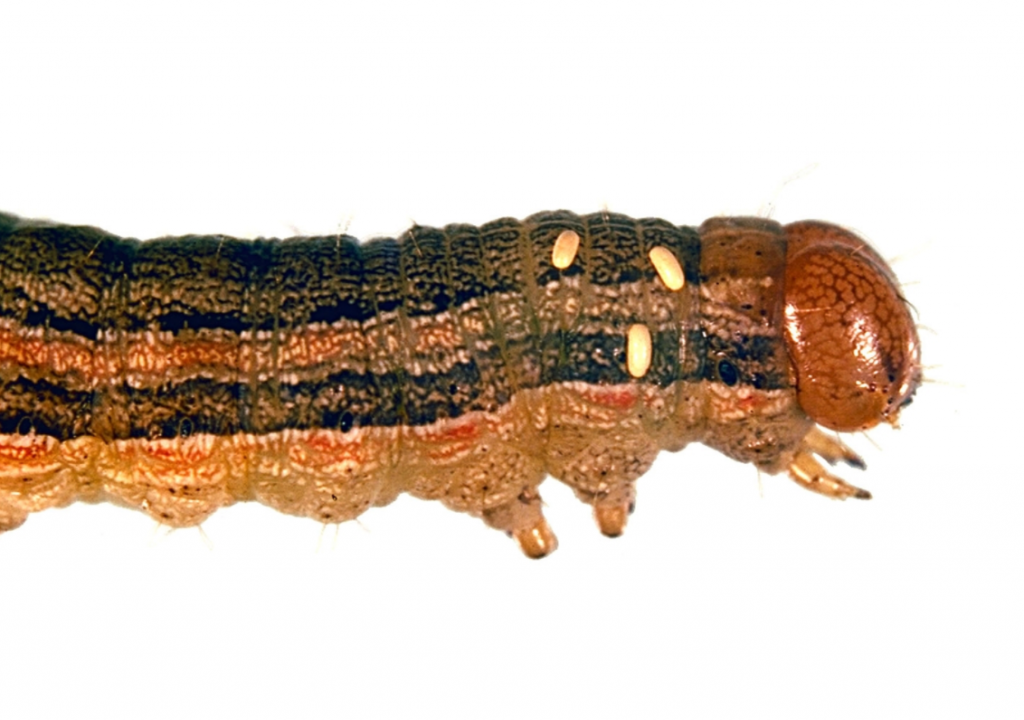Bryan Jensen, UW-Madison Dept. of Entomology and Integrated Pest Management Program
I do not like armyworms. They are difficult to predict, hard to find, feed nocturnally and their damage can be clumped within a field making thorough scouting important. Not to mention they can cause pretty significant damage.
Regardless of my personal feelings, now is the time to be looking for damage. Typically, I would expect damage to be found primarily in wheat and corn. After all, armyworms are grass feeders. However, do not ignore soybean and alfalfa. Especially new alfalfa seedings. The situation with soybean and alfalfa is that grassy weeds or cover crops may have attracted the adults during the egg laying period. When the weeds are killed, or the cover crop terminated the larvae might feed on broadleaves.
Armyworms migrate to the Midwest every year. There have been a few reports of damage in states to our south but that isn’t unusual. I would start spot-checking now and pay special attention to corn that was planted after a cereal rye cover crop. That situation has been, arguably, the most common scenario for damage in recent years. Corn with early season grassy weed problems can have injury as can corn planted next to a grassy pasture or non-crop areas. I would also not rule out clean tilled corn fields. I guess what I am trying to say is that “armyworms are where you find them”. Spot-checking the most likely damage scenarios can give you a feel for damage potential your area. Armyworm damage can be clumped within a field and within a geographical area. That makes it difficult for people to find. Did I mention I don’t like armyworms?
There are several variables to consider when contemplating treatment in corn. Armyworm density and size are at the top of my list. Once the caterpillars reach approximately 1- 1 ¼ inch length they will be soon finish feeding and pupate. Having a mixed population of small and mature larvae complicates your decision. Furthermore, small corn is remarkably resilient to defoliation. The commonly used threshold is treating armyworms if caterpillars are under ¾-1 inch and if you find 1 on 75% of the plants or 2 caterpillars on 25% of the plants. I like to review Jim Vorst’s, Purdue University’s Hail Damage to Corn article to help with control decisions. Hail can damage corn in several ways including stand reduction, direct ear damage, stalk damage. Several of those factors may come into play within a single field. However, when hail only causes defoliation (Table 3) its yield loss can somewhat consistent with army defoliation. His table helps to confirm my recommendation. For a list of insecticides labeled for use on armyworm in corn, please consult page 61-63 of A3646, Pest Management in WI Field Crops. Always try to focus control on small larvae. Percent control will be higher as will your return on investment.
Armyworm damage in wheat is also possible, however, larvae can be difficult to find because of their nocturnal feeding habits. During daylight, larvae can be found on the soil surface and hiding beneath soil clods. Areas of lodged wheat should be checked closely. The control threshold is 3 caterpillars/sq ft. and is a good starting point. Be especially protective of the flag leaf and continue to make sure they do not clip the heads prior to harvest.
Before spraying wheat for armyworm, read each insecticide label carefully. Preharvest restrictions, or PHI, are usually measured in terms of weeks or even longer and may preclude them from being used based on your anticipated harvest date.
There are many beneficial organisms that can feed on armyworms including birds, ground beetles, etc. Tachinid flies are an interesting story. Tachinids are a large family of parasitic flies. They are typically generalists and not attracted to a single host. The adult resembles a house fly and the species I see most often on armyworm may lay one or several small eggs externally on a caterpillar. Please see the classic photo of Dr. Robert Bauernfeind, University of Kansas, for details. The eggs hatch and larvae will feed internally. It is not a quick death and may not give quick knock down but is one method of natural control. View several armyworm larvae and if eggs are present it may sway your treatment decision.
This will be the first of two generations this growing season. The second generation, sometimes call the summer generation, may be a problem in July or early August. Its overall threat is independent (mostly) of the spring generation’s impact.
Armyworms are identified by the alternating light and dark bands running the length of the larvae. Their underside is usually light yellow, and their head is tan with several vein-like lines noticeable in the compound eyes. Color intensity can vary significantly. Within a field you will find individuals which are extremely light colored, and the longitudinal lines are very faint to those individuals which are very dark and the longitudinal lines are equally difficult to see.


Armyworm damage
